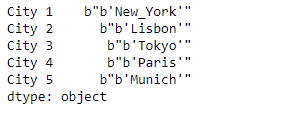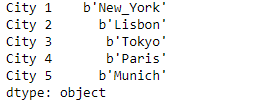Python Pandas Series.str.decode()
Series.str可以用来访问作为字符串的系列值,并对其应用几种方法。Pandas Series.str.decode()函数用于对Series/Index中的字符串进行解码,使用指定的编码。这个函数等同于python2中的str.decode()和python3中的bytes.decode()。
语法:
Series.str.decode(encoding, errors=’strict’)
参数:
encoding: str
errors: str, optional
返回:解码的系列/对象索引
示例#1:使用Series.str.decode()函数对给定系列对象的底层数据中的字符串进行解码。使用’UTF-8’编码方法。
# importing pandas as pd
import pandas as pd
# Creating the Series
sr = pd.Series([b"b'New_York'", b"b'Lisbon'", b"b'Tokyo'", b"b'Paris'", b"b'Munich'"])
# Creating the index
idx = ['City 1', 'City 2', 'City 3', 'City 4', 'City 5']
# set the index
sr.index = idx
# Print the series
print(sr)
输出 :

现在我们将使用Series.str.decode()函数来解码给定系列对象的底层数据中的字符串。
# use 'UTF-8' encoding
result = sr.str.decode(encoding = 'UTF-8')
# print the result
print(result)
输出 :

正如我们在输出中看到的,Series.str.decode()函数已经成功解码了给定系列对象的底层数据中的字符串。
示例#2 :使用Series.str.decode()函数对给定系列对象的底层数据中的字符串进行解码。使用’ASCII’编码方法。
# importing pandas as pd
import pandas as pd
# Creating the Series
sr = pd.Series([b'Mike-', b'Alessa-', b'Nick-', b'Kim-', b'Britney-'])
# Creating the index
idx = ['Name 1', 'Name 2', 'Name 3', 'Name 4', 'Name 5']
# set the index
sr.index = idx
# Print the series
print(sr)
输出 :

现在我们将使用Series.str.decode()函数来解码给定系列对象的底层数据中的字符串。
# use 'ASCII' encoding
result = sr.str.decode(encoding = 'ASCII')
# print the result
print(result)
输出 :

正如我们在输出中看到的,Series.str.decode()函数已经成功解码了给定系列对象的底层数据中的字符串。
 极客教程
极客教程